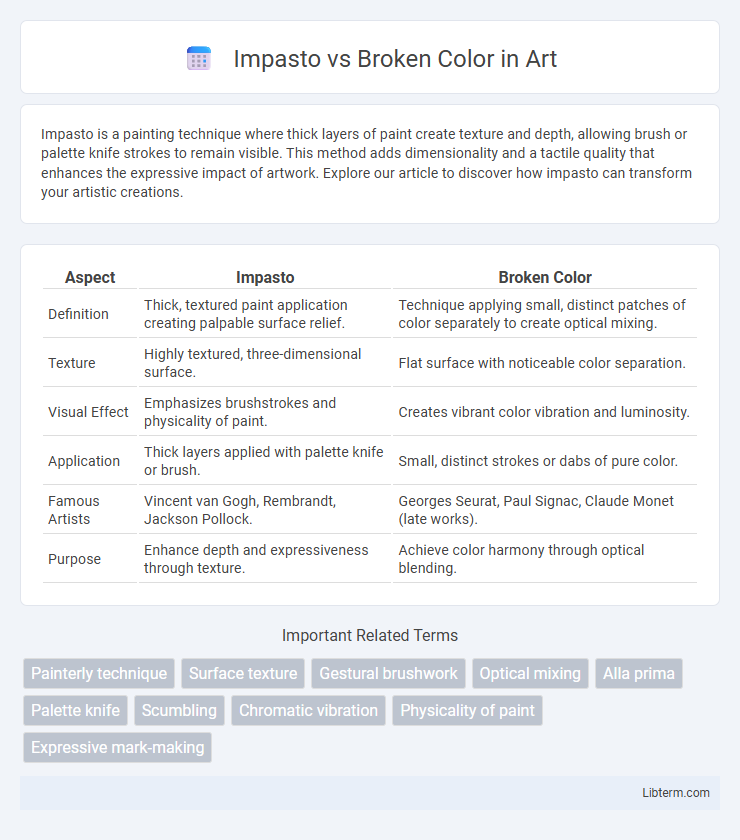Impasto is a painting technique where thick layers of paint create texture and depth, allowing brush or palette knife strokes to remain visible. This method adds dimensionality and a tactile quality that enhances the expressive impact of artwork. Explore our article to discover how impasto can transform your artistic creations.
Table of Comparison
| Aspect | Impasto | Broken Color |
|---|---|---|
| Definition | Thick, textured paint application creating palpable surface relief. | Technique applying small, distinct patches of color separately to create optical mixing. |
| Texture | Highly textured, three-dimensional surface. | Flat surface with noticeable color separation. |
| Visual Effect | Emphasizes brushstrokes and physicality of paint. | Creates vibrant color vibration and luminosity. |
| Application | Thick layers applied with palette knife or brush. | Small, distinct strokes or dabs of pure color. |
| Famous Artists | Vincent van Gogh, Rembrandt, Jackson Pollock. | Georges Seurat, Paul Signac, Claude Monet (late works). |
| Purpose | Enhance depth and expressiveness through texture. | Achieve color harmony through optical blending. |
Introduction to Impasto and Broken Color
Impasto is a painting technique characterized by thick, textured layers of paint applied to create a three-dimensional effect, enhancing the artwork's tactile quality and depth. Broken Color involves using small, distinct brushstrokes of pure color placed side by side without blending, allowing the viewer's eye to mix the colors and produce vibrant optical effects. Both techniques emphasize color and texture but differ in execution, with Impasto focusing on physical texture and Broken Color on visual color interaction.
Historical Background of Both Techniques
Impasto and broken color both emerged as influential painting techniques during the European art movements of the 19th century, with impasto gaining prominence in Baroque art for its thick, textured paint application to create dramatic effects. Broken color was popularized by Impressionist painters like Claude Monet and Pierre-Auguste Renoir, who applied separate strokes of pure color to capture light and movement more vividly. Both techniques revolutionized the traditional approaches to color and texture, deeply impacting the evolution of modern painting styles.
Key Characteristics of Impasto
Impasto is characterized by thick, textured paint application that creates pronounced brushstrokes and a three-dimensional surface on the canvas, enhancing light reflection and visual depth. This technique allows artists to emphasize texture and movement, making each stroke visibly tangible, unlike broken color which uses small, distinct patches of color to achieve optical mixing and vibrancy. Impasto's key features include heavy paint layers, palpable texture, and dynamic surface contrasts that engage viewers through tactile and visual intensity.
Defining Broken Color Technique
Broken Color technique involves applying small, distinct patches of color side by side without blending, allowing the viewer's eye to mix hues optically. This method contrasts with Impasto, which features thick, textured layers of paint that create physical depth on the canvas. Artists use Broken Color to achieve vibrancy and dynamic light effects by emphasizing color relationships rather than texture.
Materials and Tools Used
Impasto technique employs thick applications of oil or acrylic paints using palette knives or stiff brushes to create textured, raised surfaces that emphasize brushstrokes and paint volume. Broken color relies on layering small, distinct patches of pure pigment with fine brushes, allowing the eye to blend colors optically rather than physically mixing them on the palette. Both techniques demand quality brushes, with impasto favoring tools that handle heavy paint application and broken color requiring precision brushes for detailed, controlled strokes.
Application Methods Compared
Impasto utilizes thick, textured paint applied with brushes or palette knives to create pronounced surface depth and visible brushstrokes, enhancing tactile quality and light interaction. Broken Color involves applying small, distinct dabs or strokes of pure color side-by-side, relying on optical mixing to achieve vibrancy and luminosity without blending on the palette. Impasto emphasizes materiality and volume through heavy paint layers, while Broken Color focuses on color dynamics and visual effects through strategic, fragmented brushwork.
Visual Effects and Texture Differences
Impasto creates thick, textured paint layers that add depth and tactile dimension to a canvas, making brushstrokes visibly pronounced and emphasizing volume. Broken Color involves applying small, separate dabs of pure paint side by side, producing a vibrant, shimmering effect through optical mixing rather than physical blending. The visual effect of Impasto emphasizes solidity and weight, while Broken Color focuses on luminous color interactions and dynamic surface rhythm.
Famous Artists Utilizing Each Technique
Impasto, characterized by thick, textured paint application, was famously utilized by Vincent van Gogh, whose expressive brushstrokes in works like "Starry Night" highlight the technique's dynamic depth. Broken color, involving the placement of distinct, unblended patches of color, was prominently used by Impressionist artists such as Claude Monet, whose paintings like "Impression, Sunrise" emphasize light and color interaction. These techniques reflect distinct artistic intentions, with impasto emphasizing texture and emotional intensity, and broken color focusing on luminosity and visual vibration.
When to Use Impasto vs Broken Color
Impasto is ideal for emphasizing texture and expressive brushwork, making it perfect for conveying movement and emotion in landscapes or portraits. Broken color works best when aiming for vibrant, optical color mixing and dynamic light effects, especially useful in impressionistic scenes or capturing subtle tonal variations. Choosing between impasto and broken color depends on whether the artist wants bold physical texture or nuanced color interplay to enhance visual impact.
Conclusion: Choosing the Right Technique
Choosing between impasto and broken color techniques depends on the desired texture and visual impact; impasto creates thick, tactile surfaces emphasizing light and shadow, while broken color relies on juxtaposed brushstrokes to achieve vibrancy and optical mixing. Artists seeking expressive, three-dimensional effects may prefer impasto, whereas those aiming for luminous color interaction benefit from broken color. Understanding the emotional and compositional goals directs the selection of the appropriate technique for a given artwork.
Impasto Infographic

 libterm.com
libterm.com